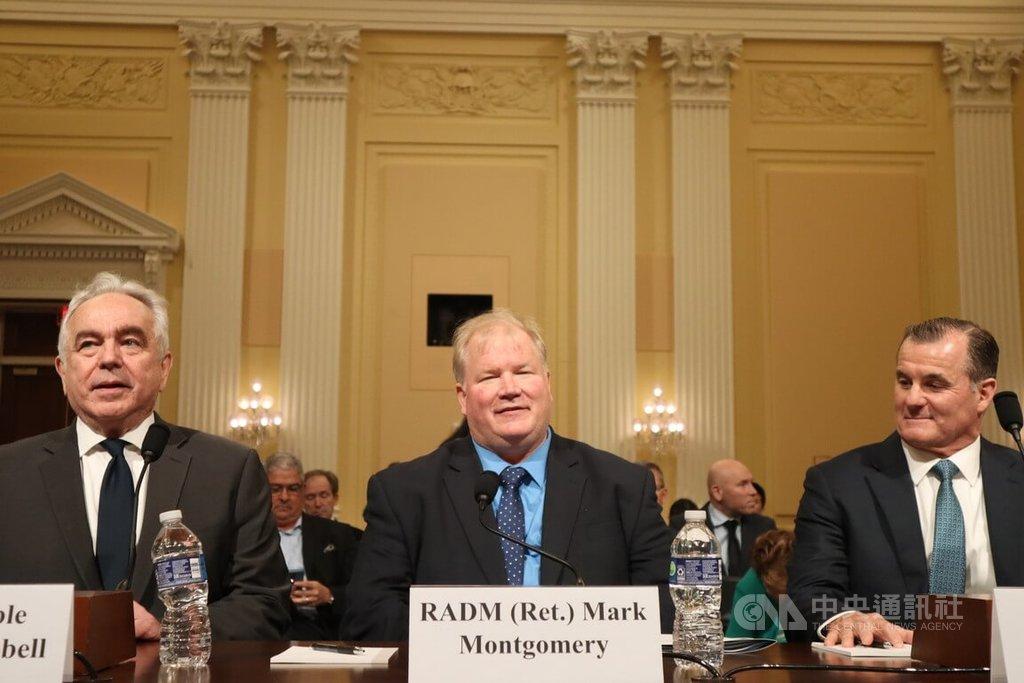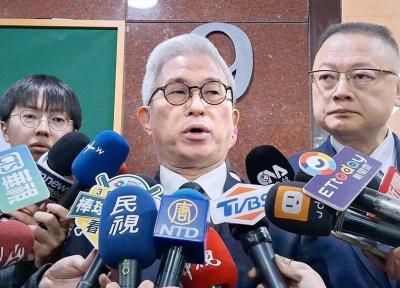Three former US military and political leaders yesterday recommended that Taiwan reasonably increase its defense budget, and the US military increase its training in Taiwan and forces in the Indo-Pacific region to deter Chinese aggression.
The US House Select Committee on Strategic Competition between the US and the Chinese Communist Party held a hearing titled “Deterrence Amid Rising Tensions: Preventing CCP Aggression on Taiwan,” inviting retired US army general Charles Flynn, former deputy secretary of state Kurt Campbell and retired US navy rear admiral Mark Montgomery to give testimonies.
Montgomery said that the US joint training mission in Taiwan should be expanded from 500 to 1,000 personnel, and advocated that Taiwan’s defense budget should reach 5 percent of GDP by 2028.

Photo: CNA
The US has never formally announced the number of troops it has stationed in Taiwan.
The US Congress passed the Taiwan Enhanced Resilience Act in 2023, instructing the executive branch to train Taiwanese troops, but the Ministry of National Defense has been slow to make progress, Montgomery said.
Taiwan still needs the investment and participation of the US military to establish an effective deterrence force with appropriate combat capabilities, he said.
Flynn also emphasized the importance of US military training.
The US could provide Taiwan with 400 Harpoon missile systems, but it is useless if Taiwan does not have teams that know how to operate, deploy and manage these systems, Flynn said.
US military training would help Taiwanese troops understand how to implement defense in depth, which is “the key value we bring as a training unit,” he said.
President William Lai (賴清德) announced a special budget in February, with the goal of increasing defense spending to at least 3 percent of GDP.
US Representative Dusty Johnson said that there is no consensus within Taiwan’s divided government to reach this 3 percent goal, questioning whether Montgomery’s proposed 5 percent goal is feasible.
Montgomery said that by spending 5 percent of GDP on the military, Taiwan would be able to purchase all the systems it needs and establish real combat readiness.
Historically for democratic countries, 5 percent is an achievable standard, he said.
Having a military budget equal to 10 percent of GDP is unrealistic for Taiwan, as this would mean purchasing US$40 billion in Foreign Military Financing (FMF) equipment from the US every year, he said.
“I believe everyone is well aware that we currently cannot even provide US$350 million of FMF annually,” Montgomery said.
Unless the Foreign Military Sales system is completely transformed and its efficiency improved by 1,000 percent, Taiwan’s military budget would not be able to reach 10 percent of its GDP, he said.
Campbell, who left office in January, said that while it is crucial to focus on what Taiwan needs to do and how to support Taiwan, the US must continue to strengthen its own capabilities and shift more forces to the Indo-Pacific region.
“We are the ultimate backing force,” Campbell said.
It is in US interests to continue supporting Taiwan, Campbell said, highlighting the achievements Taiwan has made over the past four years in technology, politics and strategy with US backing.

Taiwan is to commence mass production of the Tien Kung (天弓, “Sky Bow”) III, IV and V missiles by the second quarter of this year if the legislature approves the government’s NT$1.25 trillion (US$39.78 billion) special defense budget, an official said yesterday. Commenting on condition of anonymity, a defense official with knowledge of the matter said that the advanced systems are expected to provide crucial capabilities against ballistic and cruise missiles for the proposed “T-Dome,” an advanced, multi-layered air defense network. The Tien Kung III is an air defense missile with a maximum interception altitude of 35km. The Tien Kung IV and V

The disruption of 941 flights in and out of Taiwan due to China’s large-scale military exercises was no accident, but rather the result of a “quasi-blockade” used to simulate creating the air and sea routes needed for an amphibious landing, a military expert said. The disruptions occurred on Tuesday and lasted about 10 hours as China conducted live-fire drills in the Taiwan Strait. The Civil Aviation Administration (CAA) said the exercises affected 857 international flights and 84 domestic flights, affecting more than 100,000 travelers. Su Tzu-yun (蘇紫雲), a research fellow at the government-sponsored Institute for National Defense and Security Research, said the air

A strong continental cold air mass is to bring pollutants to Taiwan from tomorrow, the Ministry of Environment said today, as it issued an “orange” air quality alert for most of the country. All of Taiwan except for Hualien and Taitung counties is to be under an “orange” air quality alert tomorrow, indicating air quality that is unhealthy for sensitive groups. In China, areas from Shandong to Shanghai have been enveloped in haze since Saturday, the ministry said in a news release. Yesterday, hourly concentrations of PM2.5 in these areas ranged from 65 to 160 micrograms per cubic meter (mg/m³), and pollutants were

Taiwan’s armed forces have established response protocols for a wide range of sudden contingencies, including the “Wan Chun Plan” to protect the head of state, the Ministry of Defense (MND) said today. After US President Donald Trump on Saturday launched a series of airstrikes in Venezuela and kidnapped Venezuelan President Nicolas Maduro, concerns have been raised as to whether China would launch a similar “decapitation strike” on Taiwan. The armed forces regularly coordinate with relevant agencies and practice drills to ensure preparedness for a wide range of scenarios, Vice Minister of National Defense Hsu Szu-chien (徐斯儉) told reporters before a